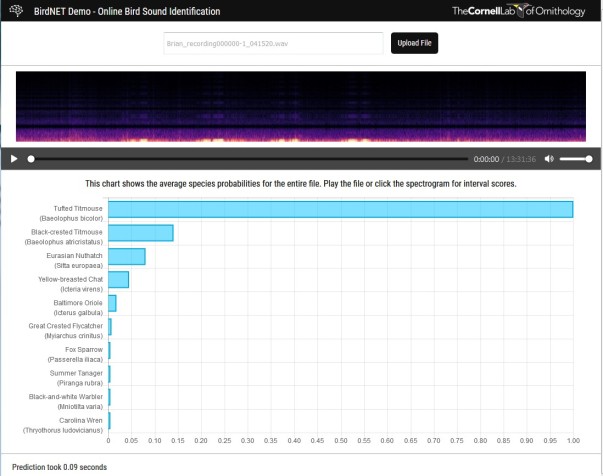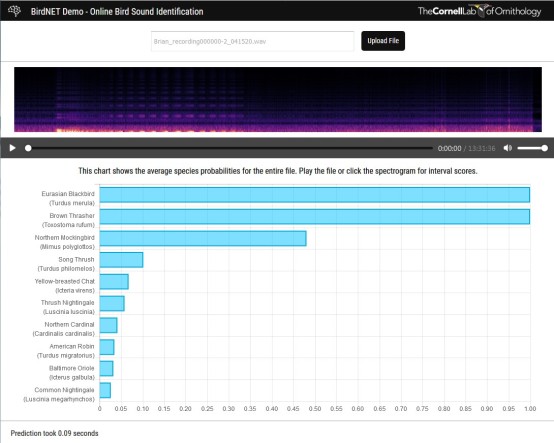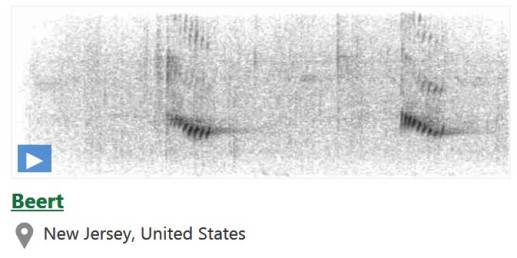You’re out birding and you hear a distinctive bird song–how do you find out what bird it is? This post describes a few ways to find out.
I’ve often read that the better birders identify 80% of their birds by sound. Not sure I believed it at first. After birding in earnest for several years, in which I’ve met a lot of birders, I think that percentage may be on the low side. When birders are in the field they open their ears to background sounds and really are in tune with the nature around them (a real experience in mindfulness).
I’m not much of an audio person, mostly a visual learner. Give me a set of verbal directions and I can’t remember past the first few. Say a word in another language and I struggle to repeat it immediately back. I have trouble remembering what was said in meetings or lectures, although learning piano helped that enormously. And I’m not great at remembering bird songs from year to year.
The easiest thing to do, I suppose, is to send an audio recording to a birder you know and just ask them. Beyond that, here are three methods I’ve used to identify a North American bird from a recording:
-
- Upload the audio file to the BirdNET site for analysis
- Use the Peterson Field Guide to Bird Sounds of Eastern (or Western) North America
- Ask for help on Facebook
These are described below. I hope you find them helpful.
1. Upload the audio file to the BirdNET site for analysis
BirdNET is an excellent resource for identifying bird songs. I have looked at other resources, and this is by far the best. BirdNET is a joint research project between The Cornell Lab of Ornithology and the Chemnitz University of Technology for the detection and classification of bird sounds using machine learning.
Consider this audio clip recorded on a smartphone by Sung, a friend of my brother Brian, who emailed to him for identification. I cropped the audio to a single song phrase on my PC:
This is a recording of a distant bird with a lot of background noise (nothing against Sung–this is often how they are). At the top of the BirdNET webpage is a link titled “Upload Recording”, and on that upload page I uploaded the WAV file above. It returned this screen:

BirdNET thinks it’s nailed it. I opened my Audubon app on my iPhone and listened to its top choice, a Tufted Titmouse, and its main recording sounded exactly like the audio using a sequence of several notes. In fact, I was looping the audio above while listening to the songs in the app and at one point they overlapped perfectly, with exactly the same timing. How cool!
I’m a bit jealous of BirdNET because it uses the same methodology that I was planning to utilize with my own software. Rather than analyzing the audio directly, it first converts the audio to a spectrogram, sometimes called a sonogram. By performing Fast Fourier Transforms on small intervals of the audio, a spectrogram is generated as a visual record of the song. Here is the spectrogram of the audio above:

The x-axis is time and the y-axis is frequency. What a great way to visualize bird sounds. Amidst all the noise in this audio clip you can see four equally timed chirps, each rising in frequency and flattening (the color indicates intensity). BirdNET converts the audio to this spectogram and operates on this image directly, using image processing software to extract out the shapes to match with bird songs. They have optimized the matching by using artificial intelligence to train on large numbers of bird songs.
Watching the spectrogram while playing audio is an excellent way of visualizing and learning bird songs! In addition to the shapes of individual tweets and chirps and burrs, many bird songs consist of multiple frequencies simultaneously, and these appear as layers above each other in the song parts in the spectrogram. This corresponds to the “tone” of a bird song, which is very important in identifying a bird despite variations in the actual song.
If you have an Android phone, a free BirdNET app is available that will record, clip and upload the audio directly to BirdNET and return the results directly in the field.
I have an iPhone, so this app is not an option. I can always email a recording and open it later on my home PC and upload it to BirdNET . However, in the field I can record a song (I use an app called Voice Record Pro) and select “Save to iCloud” when finished. Then I can go to the BirdNET upload page in the Safari browser on the iPhone, click on the upload button, and choose to upload the file from iCloud, which then returns the results as above.
2. Use the Peterson Field Guide to Bird Sounds of Eastern (or Western) North America
Sometimes BirdNET has trouble identifying a bird, or perhaps you want to personally identify a bird song and forget the artificial intelligence. There is a really incredible pair of books, the Peterson Field Guide to Bird Sounds of Eastern North America and the Peterson Field Guide to Bird Sounds of Western North America by Nathan Pieplow that between them contain over 3600 spectograms of bird sounds, usually several annotated spectrograms per species.
There is a very helpful guide at the beginning on visualizing bird sounds in spectrogram form. Also, and this is absolutely amazing, there is a visual index at the back where you can look for birds with similar spectrograms to yours by sound pattern (single note sounds, sounds made of repeated similar notes, 2- and 3-syllabled phrases, etc.). Within these sections the sounds are characterized by a short sound (cheet, churt, chewt, sheet, dzeet, and so forth) and descriptions (medium high, downslurred, etc.) with simplified spectrogram forms. Once a form looks right, you look at the short list of possible birds and the page numbers of their spectrograms, and you go look at them in more detail.
There is an online resource connected to these books here. Enter a species name and the spectograms from the book for that bird are presented and can be played out.
I recorded an interesting bird outside my window yesterday. I figured it might be a warbler. It turns out that BirdNET was down for maintenance, so I emailed the audio from my iPhone, opened it in the free audio editor Audacity on my PC, and clipped the audio to a single phrase:
To create a spectrogram you click the little down arrow to the right of the title of the track in Audacity and choose “Spectrogram”:

This displays the spectrogram in the track rather than the waveform:

Under the section “Chip Series or Unmusical Trill” in the index of the Peterson Eastern guide, I found a series of spikes with about the same timing displayed in the subcategory “An Unsteady Trill or Series”. Two birds were suggested. The Orange-crowned Warbler did not seem correct when I went to that species, but Wilson’s Warbler was a good match. I then verified it was a Wilson’s Warbler using the bird songs in my Audubon app on my phone.
Whew, that seems like a lot of work, but it was interesting and I now know what a Wilson’s Warbler sounds like!
You can also create a spectrogram right on your smartphone. This blog by Nathan Pieplow himself along with Andrew Spencer recommends the app SpectrumView for iPhones. This app has a scrolling spectrogram and recording capability. (Note: you need to go into settings and change the Audio Sample Rate to 24,000 Hz and then you can change the Maximum Frequency to 10,000 Hz.)
3. Ask for help on Facebook
Sung also provided another audio clip of a bird:
BirdNET did not know what to make of this recording:

The top suggestion, Eurasian Blackbird, would be an extremely rare bird in North America. The next two suggestions, Brown Thrasher and Northern Mockingbird, are common and can have a variety of sounds, but even I know they don’t sound like this (I think it was simply the exact repetition that yielded these suggestions). So the BirdNET option failed me.
The spectrogram looks like this, from Audacity:

I was new to the Peterson guide and didn’t find it when I looked at first. However, I had recently joined the Audio Birding North America group on Facebook. Some birders post bird sightings to their bird lists on eBird, and when you do you can upload an audio recording as well and eBird will store it and create a spectogram for it automatically. This is convenient to link to when posting queries in the Facebook group.
However, I wasn’t the one who recorded the bird, nor did I know exactly where Sung recorded it, so posting it to eBird was not an option. It turns out that Facebook allows uploading of images or video files, but not audio files. So I converted my recording to MP3 using Audacity and uploaded it to MP3 Toolbox, a site that offers free conversion from MP3 to a video MP4 format. You can also upload an image to be displayed as the video is run, which in my case was the spectrogram.
I posted the video to the group asking what this bird might be, and within a short time two experts responded that it was a female Carolina Wren. Going to the online site for the Peterson Field Guide to Bird Songs, I entered Carolina Wren to see its set of spectrograms, and found a few that matched the spectrogram above, such as

Playing this audio confirmed the Carolina Wren identification. I am awed by the fact that these experts, one from the Cornell Lab of Ornithology, knew it was a female.
Summary
So these are the three methods I’ve used to identify birds from audio recordings. Uploading audio to BirdNET is obviously the easiest, particularly if you have an Android phone with the BirdNET app. However, BirdNET is not perfect, and using the Peterson guide is a learning experience and kind of fun. Facebook is a last resort, as you don’t want to bother experts asking about common birds.
I’ve thought about getting a good tape recorder and parabolic microphone and trying to capture bird songs and upload them to the MacCaulay Library or Xeno-canto, an online database that provides access to sound recordings of wild birds by “recordists from around the world, amateur birdwatchers and professionals alike”. What a way to learn bird songs!
If you have other suggestions for identifying birds from a recording, please let everyone know in the comments–thanks!
Ron
First, I am a bit stunned as it’s only been like 9 months since your last post – at that rate I’ll never be able to catch up hehehe.
Secondly – fantastic post. Having another tool in the box for accurately identifying a bird will be extremely helpful. Now I just need to remember to hit the record button on my DSLR to hopefully capture the call along with the shots. I’ll also let Sung know what he was a catalyst for (and now referenced in a famous blog post!)
LikeLiked by 1 person
Thanks! I know, 9 months is hardly long enough time between posts… Let’s see, with your minimum of 6 posts per month (and sometimes more), that’s at least 54 posts of yours to one of mine–talk about stunning. But I’ll catch up. 🙂
Thanks again for stopping by and commenting!
Ron
LikeLike
Ron,
A question: do you know how to access/download the audio files that “you” (=the user) have uploaded/submitted to BirdNet? (can’t find the answer online…”??”)
Thanks!
LikeLike
Hi Philip,
If you used a recording app on your iPhone, saved it to iCloud, and then chose this file to upload to BirdNet from the browser on your phone, then you can log into http://www.icloud.com, enter your iPhone login and password, select the iCloud Drive folder and then the folder of the recording app, and your recording should be in that folder. You may have had to enable that recording app to be backed up under Settings–>Apple ID, iCloud, Media & Purchases (at the top so you tap your name again)–>iCloud and then turn on storage for that app. But I’m not sure of that, particularly if there was already an option to save the recording to iCloud.
If you had used the BirdNet app directly to record and analyze the recording, I don’t know how you can later retrieve that recording.
I just upgraded my iPhone to one that meets the minimum iOS version required for the iPhone BirdNet app (iOS 13), so now I’m using the BirdNet app directly on my iPhone. It works really great, but on my birding trip last week there was one time when I also recorded the bird song in my recording app so I would retain a recording of the bird for the future.
Ron
LikeLike
Nice to see you back in action Ron.
Call me old school but sometimes I can’t get my head around a lot of this new tech. For me if I heard a bird I couldn’t id I would just shrug and carry on (though it’s always niggling in the back of the mind). It makes it a bit easier we have far fewer species here in the UK to remember, and it always amazed Mrs H that I could name a songster or even a by the call. Sometimes certain species are great mimics and often of more than one other however this can be a good way to id especially if the song is ‘out of normal habit’.
Things always move forward. Digi sound recordings, DNA analysis etc all now used to clinch id when in the past we just used our eyes!
LikeLiked by 1 person
Thanks, Brian. Occasionally I would record audio of a bird that was really bugging me and then try to confirm a particular bird id or another, but there was no structure about it. I could also have mentioned in the post that I have a lot of trouble identifying musical intervals, so I don’t really have a good musical ear, so that complicates things. I had bought the Peterson guide to bird songs and it looked interesting (as I mentioned, I like writing software and thought it would be fun to work on the images), but it was my brother’s friend Sung sending two recordings without pictures that actually got me looking into this.
Now it’s back to posting bird photography. As you can imagine, I have a lot of pictures. I would do one on butterflies as an homage to your blog, but my brother just did that and my pics would pale in comparison.
Thanks again for your comment!
Ron
LikeLiked by 1 person
Great post Ron ! I used the information here to identify a bird that we heard up in Door county for my mother-in-law. I’ve sent you the spectrogram to get a second opinion from your Peterson’s Field Guide as well.
LikeLiked by 1 person
Thanks, Dan! I managed to get the bird correctly from just your spectrogram and the Peterson book on the second try (Black-Throated Green Warbler). I would not have selected my first pick if I had heard the audio. I was surprised when you told me that BirdNET also correctly identified your whistle at the bird in the recording as human. I wonder if it can tell frogs and chipmunks as well, both easily confused with birds. I know the titles of the Peterson books refer to “bird sounds” because they also cover, for example, woodpecker drumming, for which the frequency and acceleration depend on the species.
Ron
LikeLike
Thanks, you can also play with this tool too –> https://github.com/Christoph-Lauer/Sonogram
LikeLike
I have a quail type of bird in my garden and can’t identity it. I also have audio of it. Can you help?
LikeLike